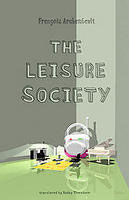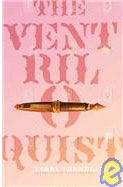The Leisure Society

by Frantois Archambault. Translated by Bobby Theodore
96 pages,
ISBN: 0889225311
The Ventriloquist

by Larry Tremblay. Translated by Keith Turnbull
64 pages,
ISBN: 0889225362
Post Your Opinion | | Theatre
by Martin Morrow
SLAPPING YUPPIES, THROWING VOICES
Frantois Archambault's The Leisure Society delivers a stinging slap in the face to the gormless yuppie middle class and its shallow consumerist values, which, thanks to Bobby Theodore's fluid translation, resonates well beyond the Montreal bourgeoisie, who were its original target.
When Archambault's La sociTtT des loisirs made its debut in 2003, at the hands of Montreal's ThTGtre de la Manufacture, it caused a stir among audiences and critics and copped Quebec's Masque award for best new play. I was introduced to this English version the following year, at a staged reading in Calgary, and found its satire of frazzled, baby-abusing parents shocking and hilarious¨Neil LaBute, QuTbTcois style. It went on to receive its premiFre in 2005 at Alberta Theatre Projects in a production that ably exploited its wicked humour while also exposing its flaws. There has since been another staging in Edmonton¨perhaps a reflection of how well suited the play is to Alberta's land of plenty.
Archambault's principal yuppie scum are Mary and Peter, a thirtysomething married couple that seem barely able to cope with their prosperity. They work overtime to maintain their posh lifestyle, can't stand their incessantly crying child, are perpetually kicking booze and cigarettes, and have a sporadic sex life only the celibate could envy. Nonetheless, they foolishly soldier on with their plans to adopt a little Chinese girl¨as Mary explains, they need someone who can play their grand piano¨and with their efforts to divest themselves of Mark, a divorced friend they consider a bad influence.
Most of the play's action takes place at a dinner party at Peter and Mary's, where the weak-willed pair intend to give Mark the brush-off but instead wind up getting drunk with him. Mark has brought along Paula, his twenty-one-year-old "fuck friend", whose presence inspires a soused and sexually frustrated Mary to propose the threesome she and Peter have long talked about¨much to Mark's chagrin, until nervous Peter backs down and he quickly agrees to pinch-hit for him.
At that point, Archambault belatedly makes Peter the primary focus, charting his growing despair at his "perfect" life, and the play, instead of reaching a climax at the party, stutters to a close in three final scenes set a week later that awkwardly hammer home the tragic absurdity of his and Mary's situation.
Archambault's forte isn't structure but characterisation and sharp, funny dialogue. With depressive Peter and the near-hysterical Mary, he makes us alternately laugh and wince at the picture of a marriage slowly turning sour (especially telling is the way they insult each other while trying to calm their lachrymose infant¨a nasty exchange overheard by their guests on the baby monitor). If they are clueless, their macho pal Mark thinks he has things sussed, having neatly divided his emotional life into love, reserved for his daughter, and sex, with any bimbo he can coax into bed¨including, of course, young and adventurous Paula, who is a bit dumb, but by no means as prodigiously stupid as her elders (Peter's sage advice to her about borrowing money to save for the future is a banker's wet dream).
Theodore, who previously translated Archambault's Governor General's Award-winning comedy 15 Seconds, has gone for a universal flavour here, Anglicising the characters' French names for a start. More importantly, though, he captures the sizzle and pop of the playwright's wit. Taking shots at the middle class is a time-honoured artistic sport, but Archambault has found fresh follies to decry in the Generation X edition.
Take this however you like, but there's nothing about The Leisure Society that says "made in Quebec". Larry Tremblay's The Ventriloquist, on the other hand, is exactly the kind of surreal, multi-layered psycho-fantasy we've come to expect from the contemporary playwrights of la belle province. The English version of Tremblay's 2001 play has been translated by veteran director Keith Turnbull, who also staged the English premiFre at Toronto's Factory Theatre last spring, in a production starring two of my favourite actors, Nigel Shawn Williams and Meg Roe. Without the French original to compare, I can't say how accurate Turnbull's translation is, but some of its grammatical errors make me wonder if his sloppiness extends to his choice of English words and syntax.
Whatever the case, this is quite the mind-bending little play. It's bracketed by two scenes: the first, a "curtain raiser", features a performance by a ventriloquist and his female dummy; the last finds the ventriloquist, now an emotionally stunted young man, locked in his bedroom and playing with the same doll. Sandwiched between these two slices of apparent reality is the ventriloquist's fantasy, in which he plays the role of Dr. Limestone, a therapist treating the "doll"¨now come to life as a troubled young woman named Gaby, who is suffering from a four-year writer's block.
On her sixteenth birthday, Gaby cut off her braids, insulted her best friend and, despite the protests of her parents, locked herself in her bedroom with her new Parker pen, where she began writing with a ferocious, coffee-fueled creativity to rival Balzac. When she discovered that every story she wrote came true, she set about composing the most beautiful novel in the world.
However, Gaby made the mistake of reading her masterpiece to her adored older brother, a poet, who jealously absconded with it to Africa, leaving her, as she says, "incapable of writing a single line."
Incest, voodoo and hints of sexual abuse are among the disturbing ingredients that Tremblay mixes into this strange concoction of psychotherapy, literary ambition and ventriloquism. In part it's a compelling, often-confusing twist on the old mad-ventriloquist genre (in fact, Gaby's name may be an homage to The Great Gabbo, the 1929 film with Erich von Stroheim as a crazed vent), but it also suggests the therapeutic use of dolls and role-playing, particularly with child patients.
Tremblay, whose other works include The Dragonfly of Chicoutimi, is best known for his monologues and, while this drama contains interplay between two onstage characters and six offstage voices (including Balzac), its most striking passages are Gaby's feverish narratives, which are filled with the obsession and exhilaration of invention. They stick in your head, along with the central ventriloquism conceit. Voice throwing is often considered one of the lower forms of entertainment, a glorified parlour trick, but Tremblay turns it into a complex metaphor for the relationship between creator and creation, in which the artist must project himself into his characters to animate them, while pretending they have a life of their own. And when Gaby, Dr. Limestone and even Balzac let loose with colourful streams of bilious invective, you're also reminded of the literal meaning of "ventriloquism"¨speaking from the stomach. ˛
Martin Morrow is an award-winning theatre critic and the author of Wild Theatre: The History of One Yellow Rabbit.
|